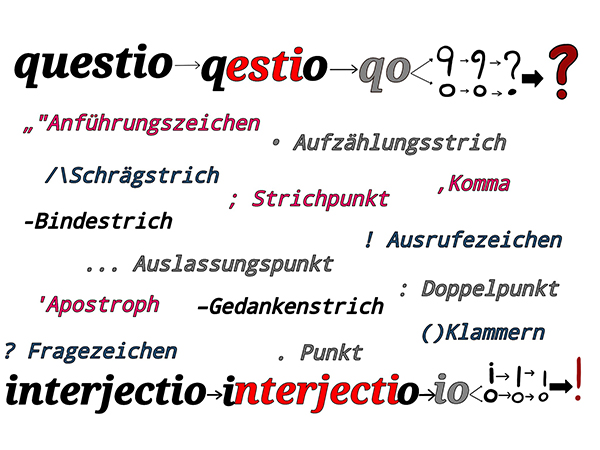By Oula Mahfouz
Punctuation marks – periods, commas, colons, question marks, semicolons (semicolons), brackets, exclamation marks, dashes and quotation marks – are all essential in written communication. They are used to organize texts and make it possible to express thoughts and feelings precisely. Conversely, punctuation marks help considerably to understand texts and to be able to read them out loud. Without punctuation, many sentences are ambiguous and the internet is full of example sentences that can only be understood if a comma is inserted.
The history of punctuation spans many centuries and is closely linked to the respective language and culture. Even in the early writing systems of Ancient Egypt, Babylon and Greece, there are references to the use of signs to emphasize and structure texts. The Greeks, for example, used the slanted dash sign (/) to mark paragraphs.
The ancient, predominantly oral cultures, in which there were relatively few texts, were replaced in the Middle Ages by the culture of manuscripts, in which large numbers of books were copied by hand and punctuation marks were used individually. At this time, there were only a few punctuation marks that were used without fixed rules. However, everything changed with the groundbreaking invention of letterpress printing around 1450 by Johannes Gutenberg. Book printing with movable metal type enabled the mass distribution of books and magazines and forced the standardization of punctuation marks to ensure a uniform appearance.
Martin Luther’s intellectual revolution, his translations of the Bible and the liturgy he demanded in German contributed to the development of a standardized German written language and influenced the use of punctuation marks in German-language texts. For example, Luther used the virgel (slash) instead of the comma, which was later replaced by the comma.
With the spread of the written German language, grammarians began to publish rules on German grammar and spelling, in which the use of punctuation marks was described. The actual codification of these rules took place at the same time as the introduction of compulsory education in the German-speaking world in the 17th century.
The spread of school grammars, in particular by Konrad Duden in the 19th century, accelerated the development of the standardized use of punctuation marks. This led to the emergence of the punctuation and word marks we know today, including brackets, exclamation marks, dashes and quotation marks.
Towards the end of the 19th century, Konrad Duden and the founding of the German Empire in 1871 contributed to the creation of a uniform German spelling standard. The final rules were laid down at the first spelling conference in 1902, and punctuation rules were not introduced until 1903.
The punctuation rules were only included as an equal part of the German spelling reform of 1996, which has been in force in schools and public authorities since August 2006. This changed the way punctuation marks such as the period and the comma are used, particularly in relation to comma placement. The modern system of punctuation is now set out in Chapter E of the German orthography.
In Arabic, punctuation marks were not known at the beginning of the spread of Islam. With the increase of errors in the Arabic language due to the conversion of non-Arabs to Islam and the change in the meaning of some words, dots were placed on the letters and punctuation marks began to be observed. The first to dot the letters was Abu Al-Aswad Al-Duali.
Dots and lines became a circle with a dot or a line in it to separate sentences. Abu Al-Aswad Al-Duali was a scholar and grammarian who lived in the 7th century. He is often recognized for his work on the development of Arabic grammar and orthography, as well as his contributions to establishing the pronunciation rules of Arabic.
Ahmed Zaki Pasha introduced the punctuation marks used today into the Arabic language in 1912. He was an Egyptian politician and diplomat who played a significant role in Egyptian history. He served as prime minister and had a great influence on the modernization of Egypt.
Today, punctuation marks are an indispensable tool in our daily communication in the written language.
tun23112201
Die Geschichte der Satzzeichen geht über Jahrhunderte zurück. Foto: tünews INTERNATIONAL / Sara Al Sagheer
002211




